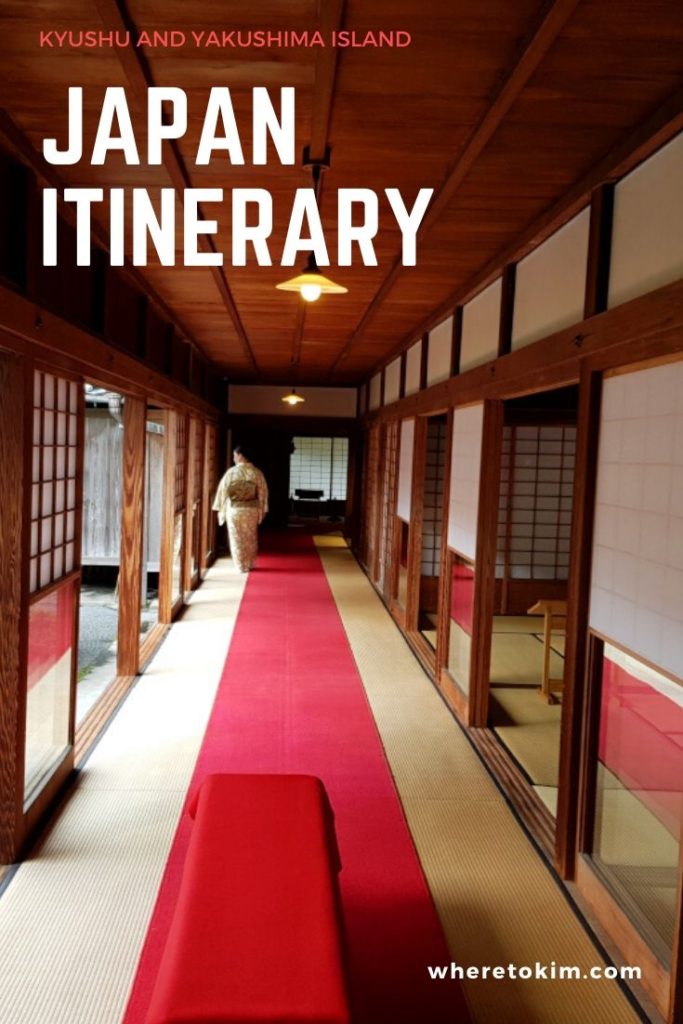How to spend 2 weeks in Kyushu, Japan? You can read all about it in this Japan travel itinerary focusing on Kyushu and Yakushima Island.
Have you seen the highlights of Japan already and are you looking for travel inspiration for your second trip to Japan? Then this Japan travel itinerary is for you.
With this travel itinerary, you will explore the southern part of Japan: the islands Kyushu and Yakushima in two weeks. Kyushu is Japan’s third-largest island and can easily be reached by car, train or air.
The most interesting part about visiting this part of Japan is the laid-back character of the area. If the weather is nice you can easily mistake parts of Kyushu for a tropical vacation: the vegetation is different from mid and north Japan, fruit is affordable and the must-see places are in the rural areas.
As a special side trip, this Japan travel itinerary will lead you to Yakushima Island: a subtropical island that has a mysterious feeling to it. Yakushima Island is ideal for those who love hiking.
Japan itinerary outline
- Fukuoka – Day 1
- Nagasaki – Day 2 – 4
- Kagoshima – Day 5 – 6
- Yakushima Island – Day 7 – 9
- Miyazaki – Day 10 – 11
- Mizukami – Day 12
- Aso – Day 13
- Beppu – Day 14 – 15
- Practical information (including transport details and budget)
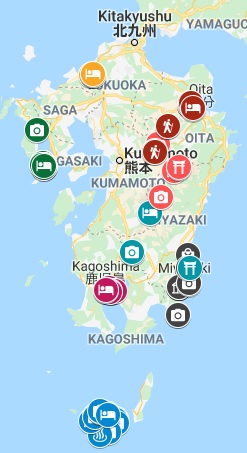
Japan itinerary map
You can find all the places mentioned in this itinerary in my Japan travel itinerary – 2 weeks in Kyushu and Yakushima Island Google map.
Fukuoka
Day 1: Hakata Ramen, Castle Ruins, Nakasu Street Stalls
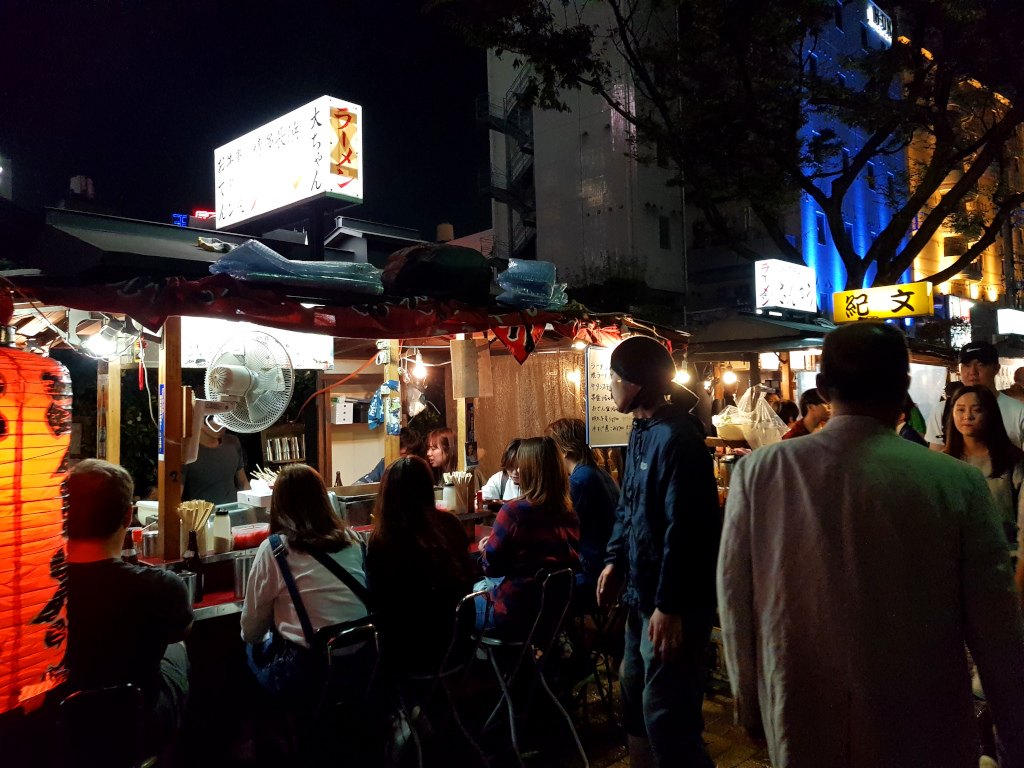
Your first day in Japan! From the airport, it is only a ten-minute subway ride to Nakasukawabata Station. Buy your Japanese public transport card (Pasmo or Suica) at a convenience store at the airport and store it with enough money for a few rides in Fukuoka and Beppu.
When you get off the subway you’re right in front of Ichiran’s Tenjin branch where you can eat your first Japanese meal of the trip after checking into your hotel: Hakata Ramen; the pork noodles soup from the Fukuoka area. Afterward, head over to the nearby castle to explore Fukuoka Castle Ruins.
Dinner tonight is at the Nakasu Street Stalls (Yatai). These stalls are located along the canal and attract a lot of people at night. Some of the dishes you can try here are yakitori (grilled chicken skewers), oden (hot pot noodles), a variety of dumplings and Hakata Ramen. Just take a seat at one of the stalls and strike up a conversation with the people around you.
Where to stay in Fukuoka
I stayed at Hotel WBF Fukuoka Nakasu near Nakasukawabata subway station in the Tenjin area. This hotel is within walking distance from Ichiran, the food stalls, Canal City and Hakata train station. I enjoyed my stay at the hotel after an initial discussion about the price; they had to call some people to confirm the amount on my booking reservation over the amount they usually charge.
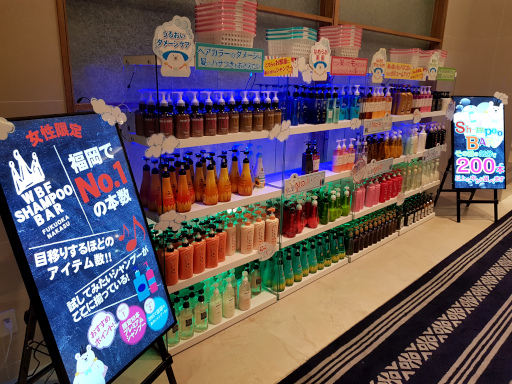
In the lobby of the hotel, you can choose your shampoo and conditioner for the night, which is a very nice touch and a good opportunity to try Japanese brands. The rooms were clean and, because I booked a twin room, big enough for two people and two suitcases.
Nagasaki
Day 2: Fukuoka Canal City, Hakata Train Station, Braised Pork dish
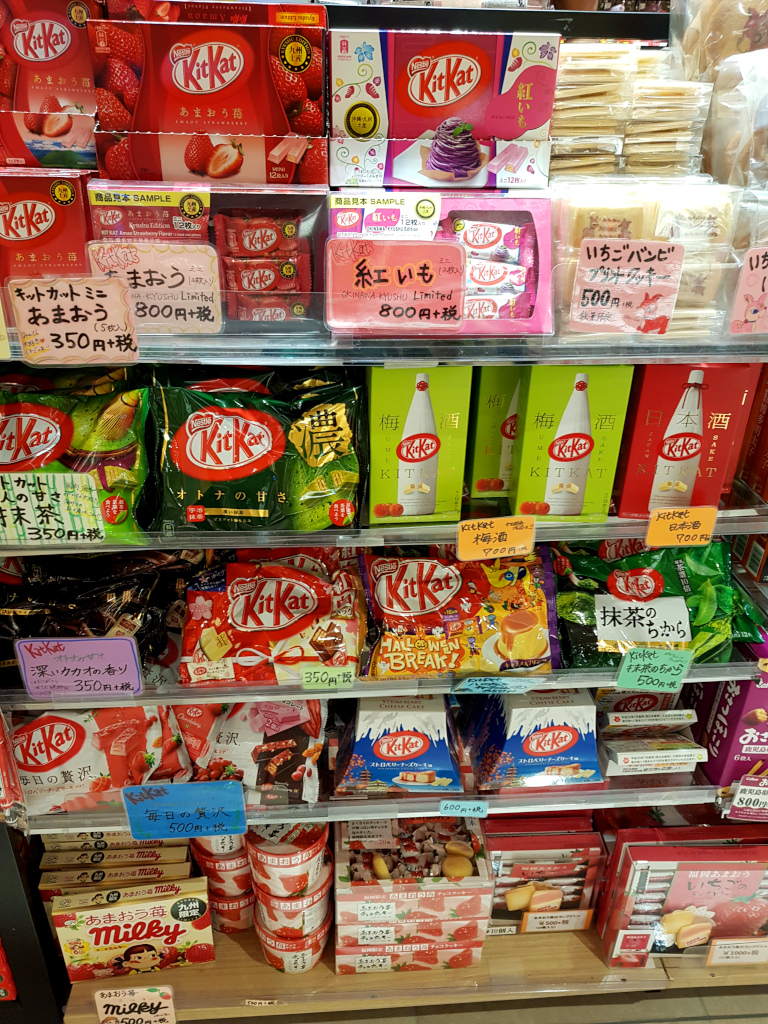
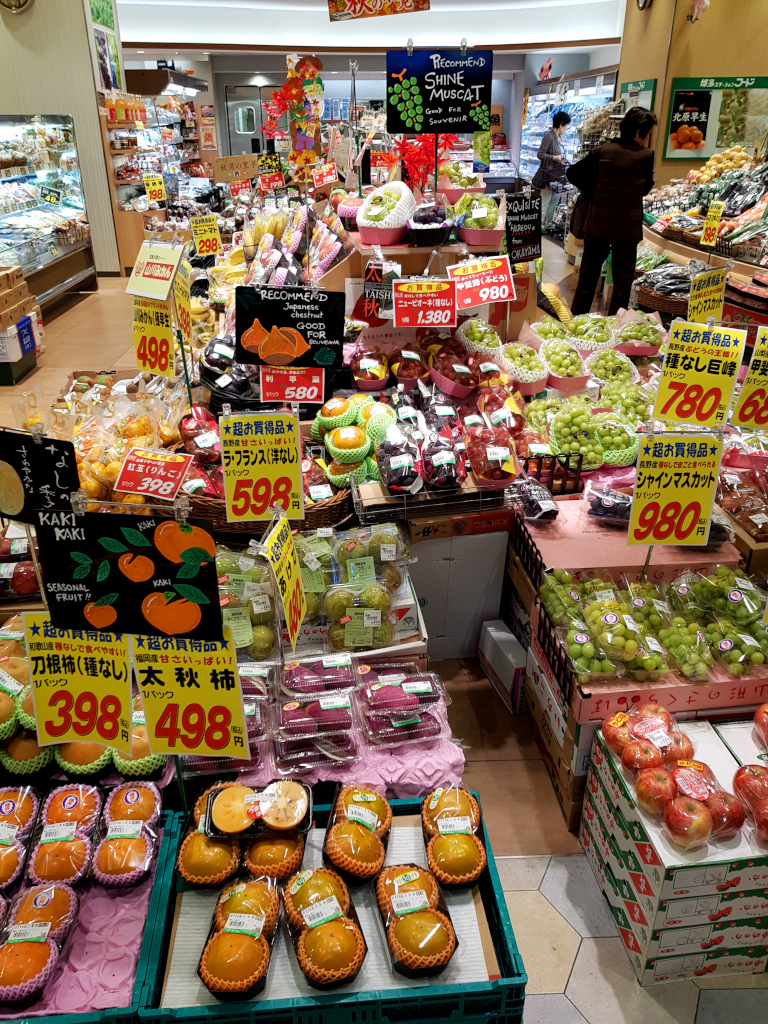
Visit Canal City shopping mall in the morning and continue your shopping spree at Hakata Train Station. If you’re planning to buy some very touristy Japanese souvenirs for your loved ones, then this is one of the best places to do so on this trip. It’s not a good idea to buy the heavy stuff yet but some regional sheet masks, socks, t-shirts, and KitKats shouldn’t weigh you down too much.
In the afternoon, pick your luggage up from the hotel and head back to the train station to get your Japan Rail Pass. It is time to go to Nagasaki by train. The train ride takes about two hours and twenty minutes but there is plenty to see during the ride.
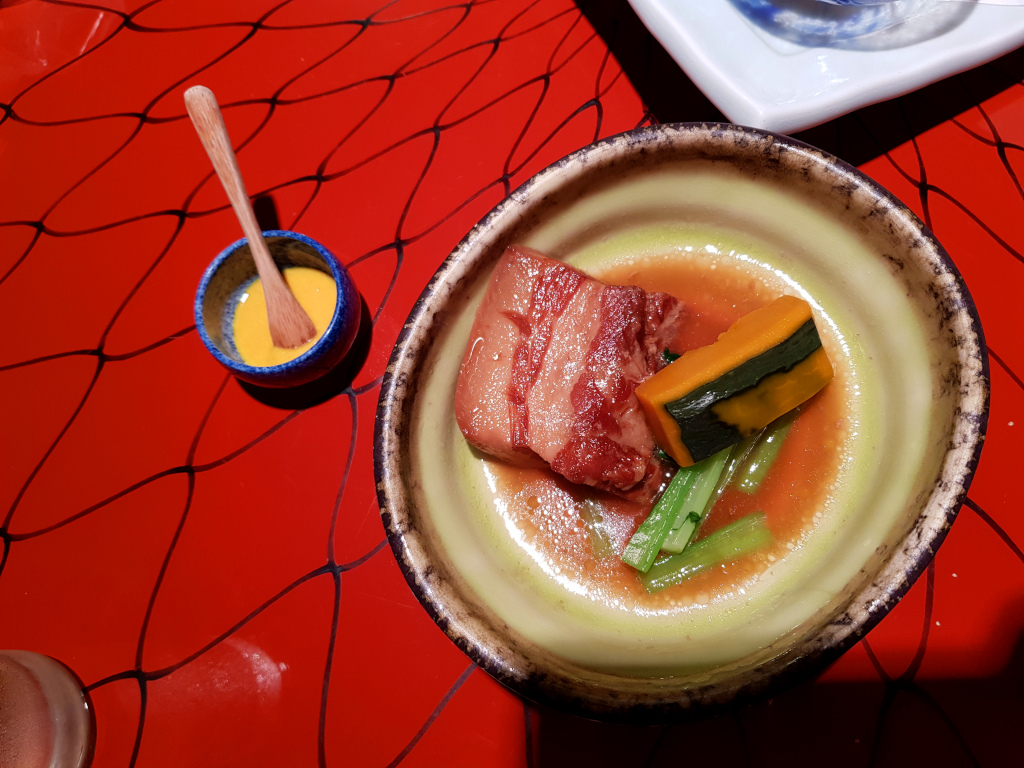
After checking into your hotel, head to shopping area 観光通り and find a good restaurant that serves braised pork (Buta Kaku Ni). I can recommend Shippoku Hamakatsu.
If you want to visit Huis ten Bosch while you’re in Nagasaki, then it’s better to head to Nagasaki early in the morning so you can do the activities scheduled for day 3 today. I wanted a slow start (recovering from jetlag) and chose to spend more time in Fukuoka instead.
As a Dutch person, I felt very much at home in Nagasaki but going to Huis ten Bosch to see tulips and mills and Dutch houses was a bit too much for me after the Dutch Slope and Dutch Trading Post. Otherwise, Huis ten Bosch (Little Holland) can be a good day trip from Nagasaki.
Day 3: Dejima, Dutch Slope, Glover Garden, Chinatown
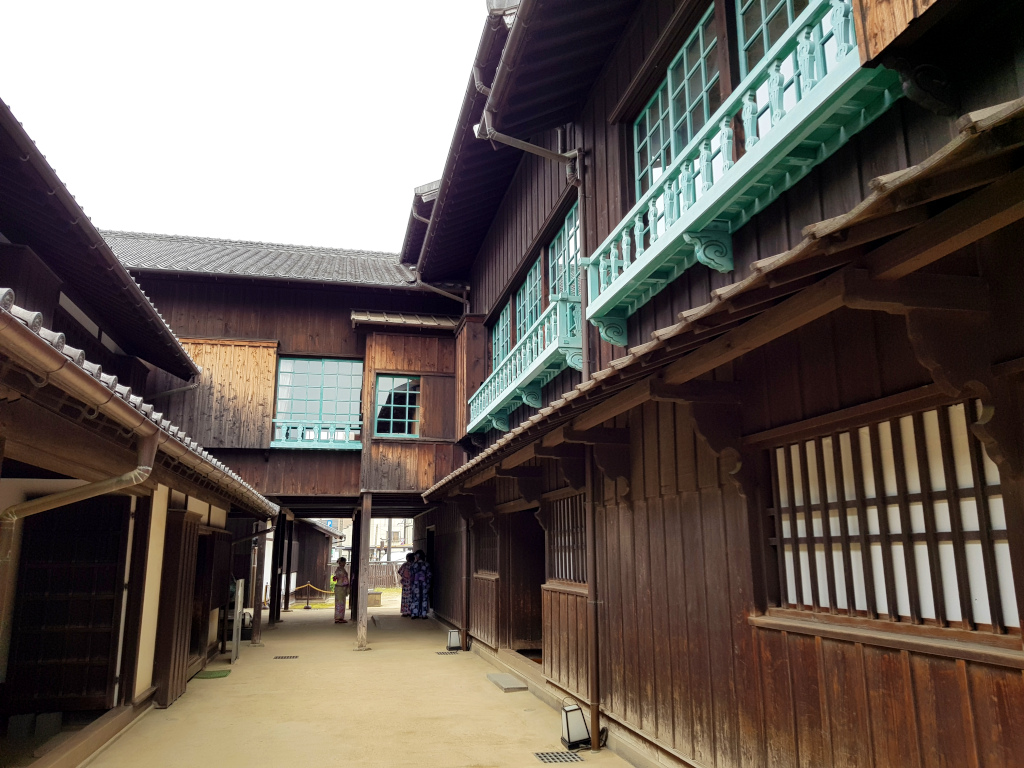
Time for a walk around town. The first stop for today is Dejima, a former Dutch Trading Post in the middle of Nagasaki. This trading post housed Portuguese traders and later also Dutch traders from 1641 onwards to separate them from the rest of society. Dejima Island was the only place of direct trade between Japan and the rest of the world.
Head to Nagasaki’s China Town for brunch or lunch. Try Champon (noodles, seafood, pork, and vegetables in white bouillon) and Sara Udon (fried champon).
Next up is the Dutch Slope. Follow the street up the hill to view the former residences of traders who moved there after Nagasaki opened its port for foreign trade in 1859. For two centuries the Dutch were the only Westerners allowed in the country, hence the name Dutch Slope.
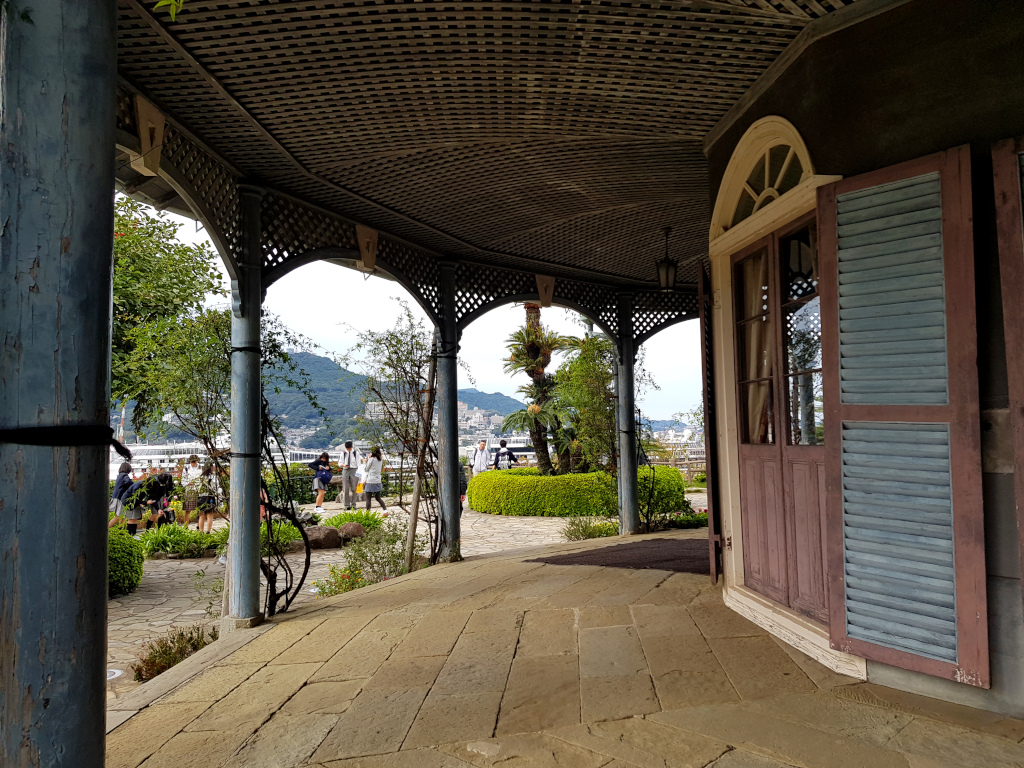
From the Dutch Slope, it is only a few minutes’ walk to the ‘elevator’ to Glover Garden. The house within the garden (Glover House, after Thomas Glover, a Scottish merchant who moved to Nagasaki after the port opened) is the oldest Western-style wooden building in Japan.
Take a stroll through the garden and enjoy the view of Nagasaki harbor from above. After leaving the garden at the bottom you pass by Oura Catholic Church. A church built for the foreign traders around 1864 and one of the oldest surviving Christian churches in Japan.
In the streets surrounding the church, you can find many tourist shops with interesting souvenirs and food to try.
Day 4: Peace Park and Museum, Mall, Ropeway Mount Inasa
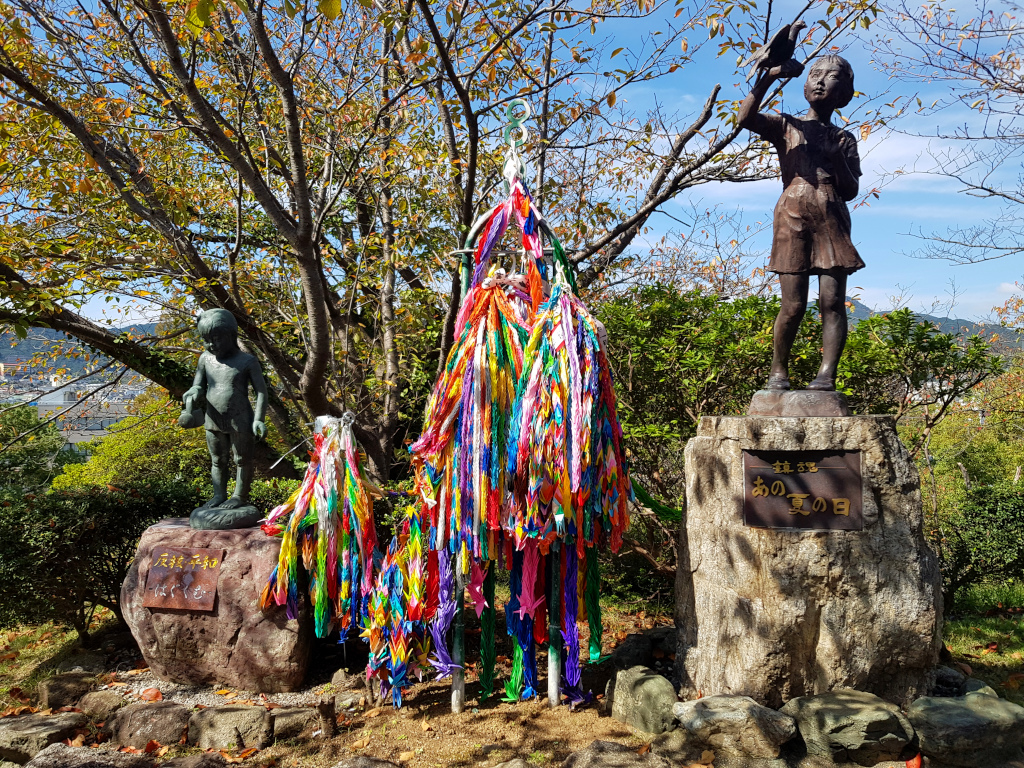
Whereas yesterday focused on the 1600s until the 1800s, today focuses on more recent history: the atomic bomb that was dropped on Nagasaki in 1945. This morning you will visit the Atomic Bomb Museum and National Memorial to the victims. The museum is quite impressive and especially the objects that were scavenged from the ruins and the pictures and testimonials of people that survived the bombing make an impact.
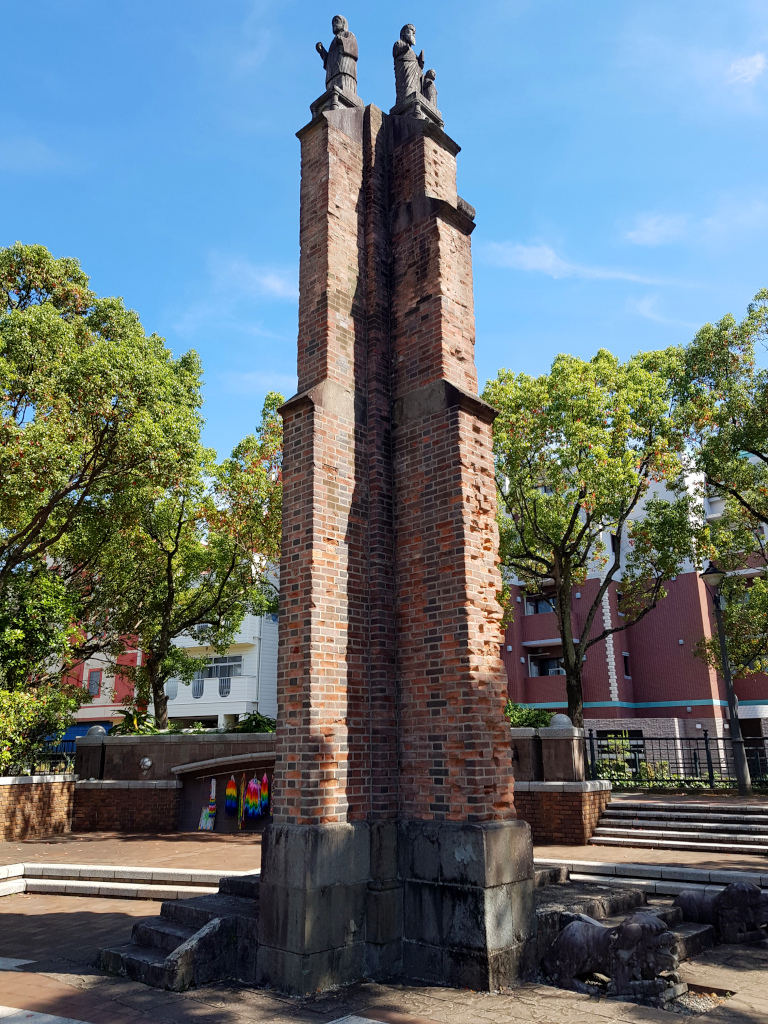
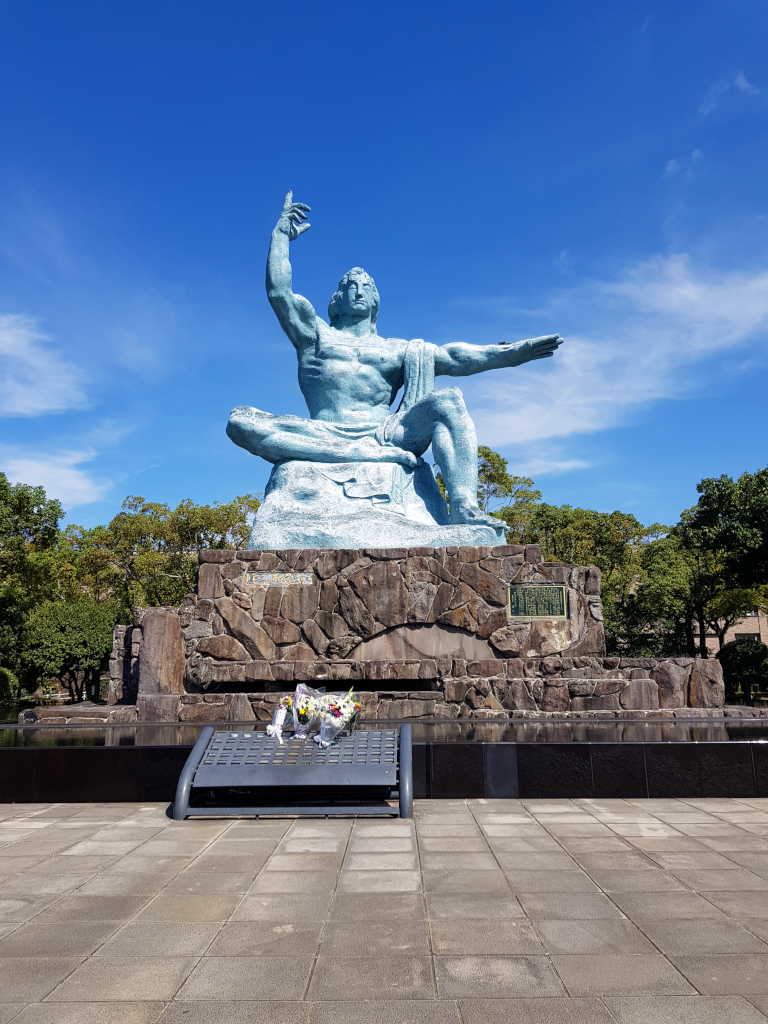
On your way from the Atomic Bomb Museum to the Peace Park, you pass the Hypocenter Park with the black column marking the epicenter of the explosion and the single remaining pillar of the old Urakami Cathedral.
The Peace Park on top of the hill is filled with sculptures commemorating the atomic bombing of Nagasaki. The visit to the Atomic Bomb Museum and Memorials leave you with both peaceful and heavy feelings.
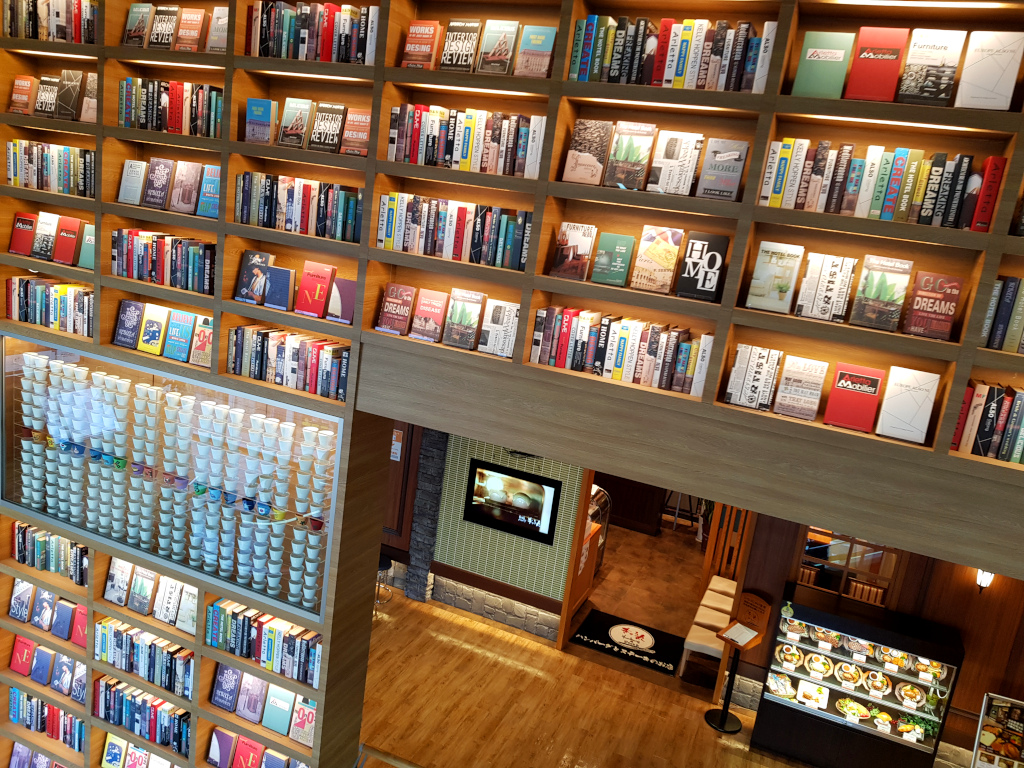
Take the tram to Mirai Nagasaki Cocowalk Mall for some afternoon shopping. I recommend a visit to the bookstore and Nana’s Green Tea cafe in the middle of the bookstore. I visited other branches of this cafe in Miyazaki and Tokyo; their matcha and hojicha flavored chocolates, tea and ice creams taste wonderful.
When evening falls, head to the Fuchi Shrine Ropeway Station to take the cable car to the Mount Inasa viewpoint. From the viewpoint, you have a very good view of the illuminated city of Nagasaki.
A practical tip: have your luggage forwarded to your hotel in Kagoshima for optimal freedom of movement tomorrow! Your hotel can probably send it for you or direct you to a convenience store nearby. Make sure to fill in the forms and drop off your luggage before 4 PM.
Where to stay in Nagasaki
Where to eat in Nagasaki
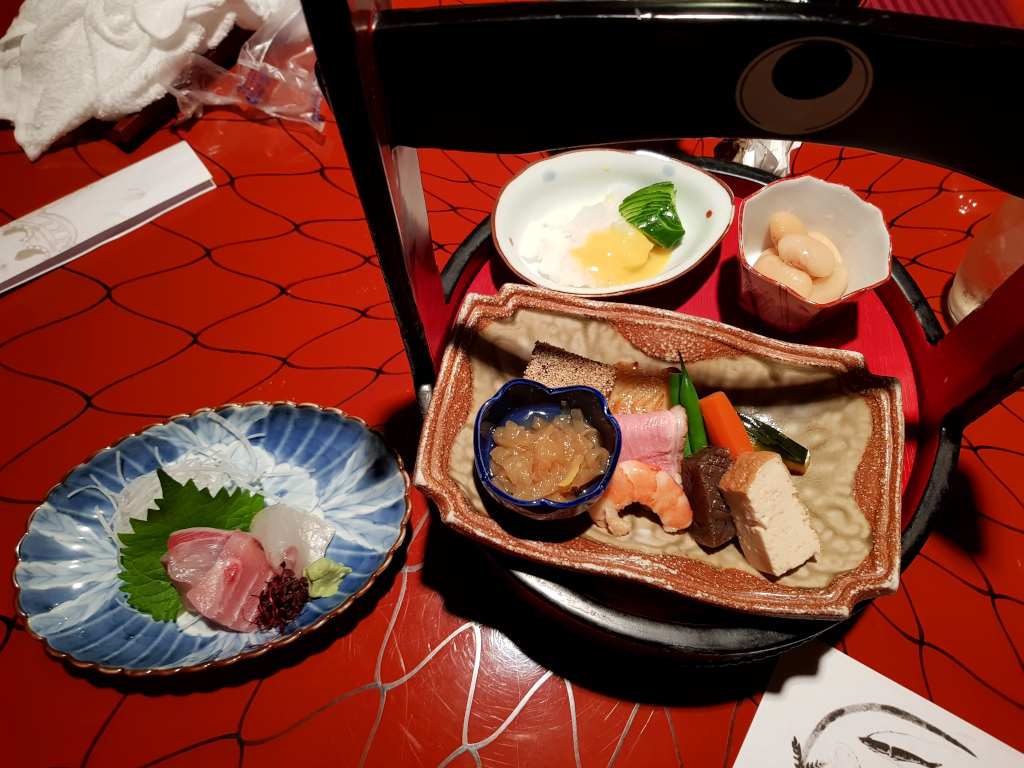
Shippoku Hamakatsu: not a budget meal, though still cheaper than a regular restaurant meal in my country. Try their multi-course dinner with braised pork. I enjoyed the taste of the dishes very much.
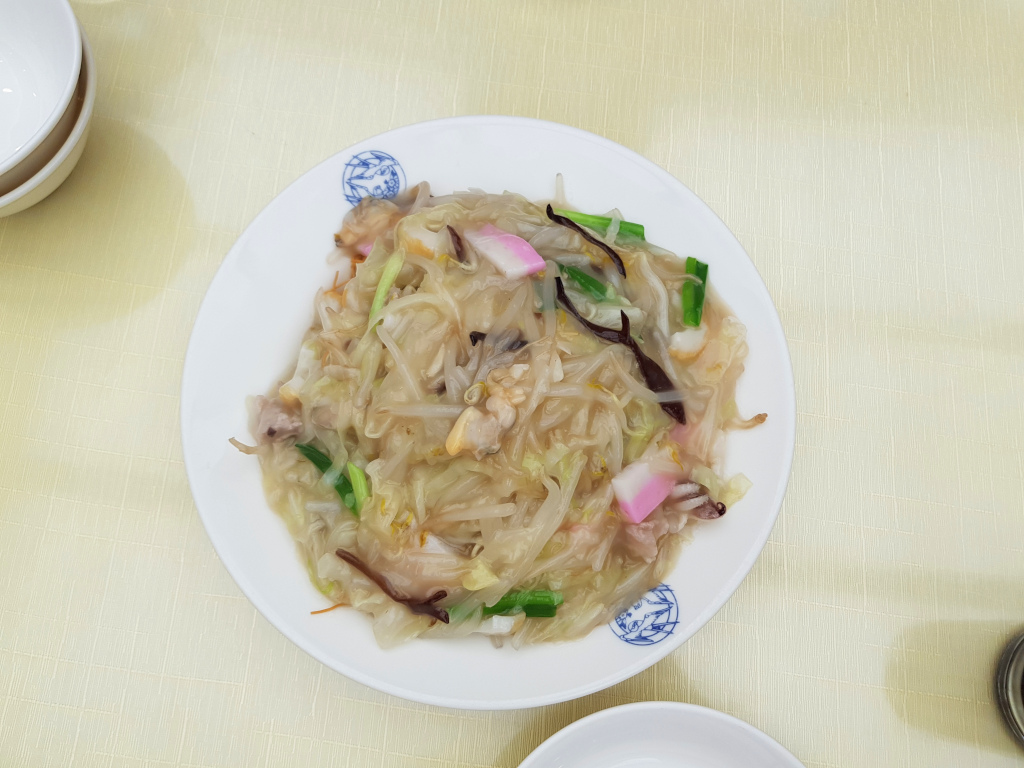
China Town: you can’t go wrong here as there are many restaurants in the streets of China Town.
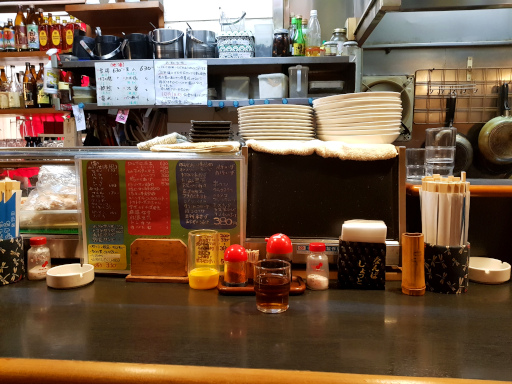
On my way back from the peace park to the tram station, I had lunch at this brilliant little pub called なんばしよっと hidden behind a door that suggests it is a toilet. Be brave and go in for a very good meal with lovely hosts at a low price. This is what they mean with unique and authentic places to have lunch at.
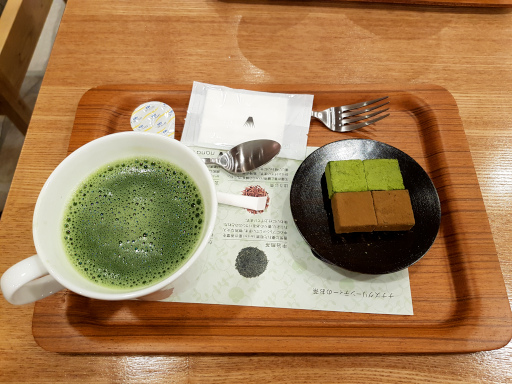
Nana’s Green Tea cafe at Mirai Nagasaki Cocowalk Mall.
Kagoshima
Day 5: Train ride to Kagoshima, Tenmonkan, Tea shop
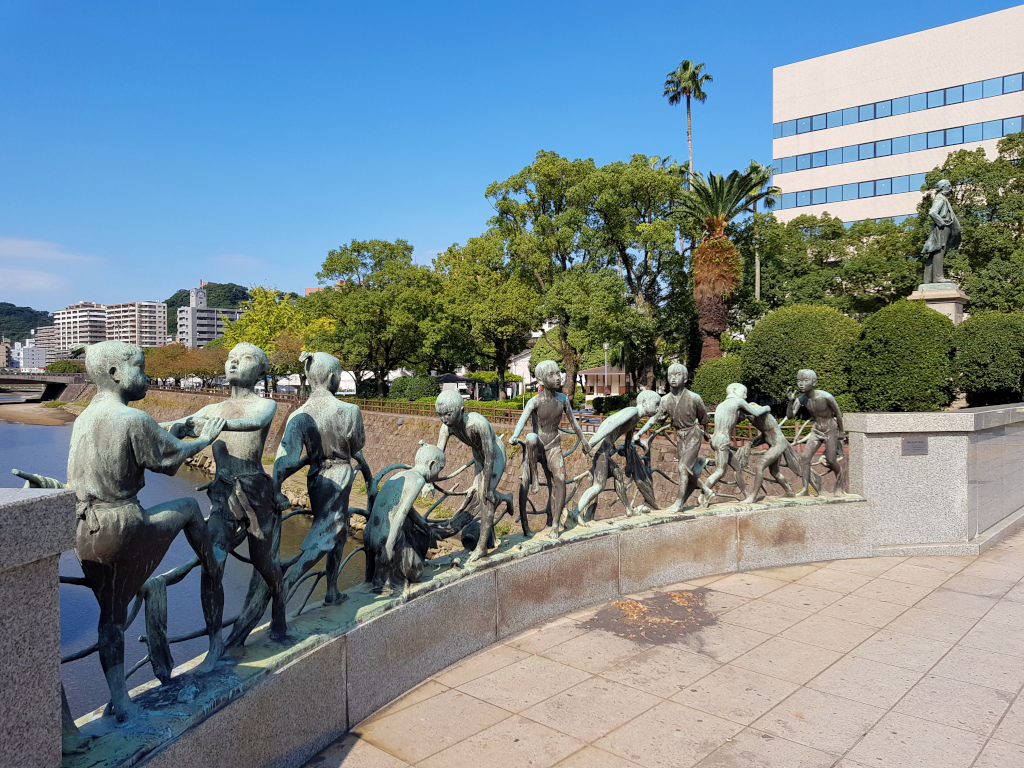
Prepare for a 4 hours and 30 minutes train ride to Kagoshima, via Hakata Station in Fukuoka. If you sent your luggage ahead you’ll be free to get out at any stop along the way to go sightseeing. I considered stopping at Kumamoto to visit the castle but decided against it as the castle was damaged in an earthquake a few years back and might not be worth the trip. Instead, I walked through some non-touristy neighborhoods in Kagoshima until I reached the Tenmonkan Shopping Center.
If you like tea, then I can recommend Birouen Tea Store in Tenmonkan.
Day 6: Sengan-en Garden, Sakurajima Island volcano, Nagisa Lava Trail and Foot Bath
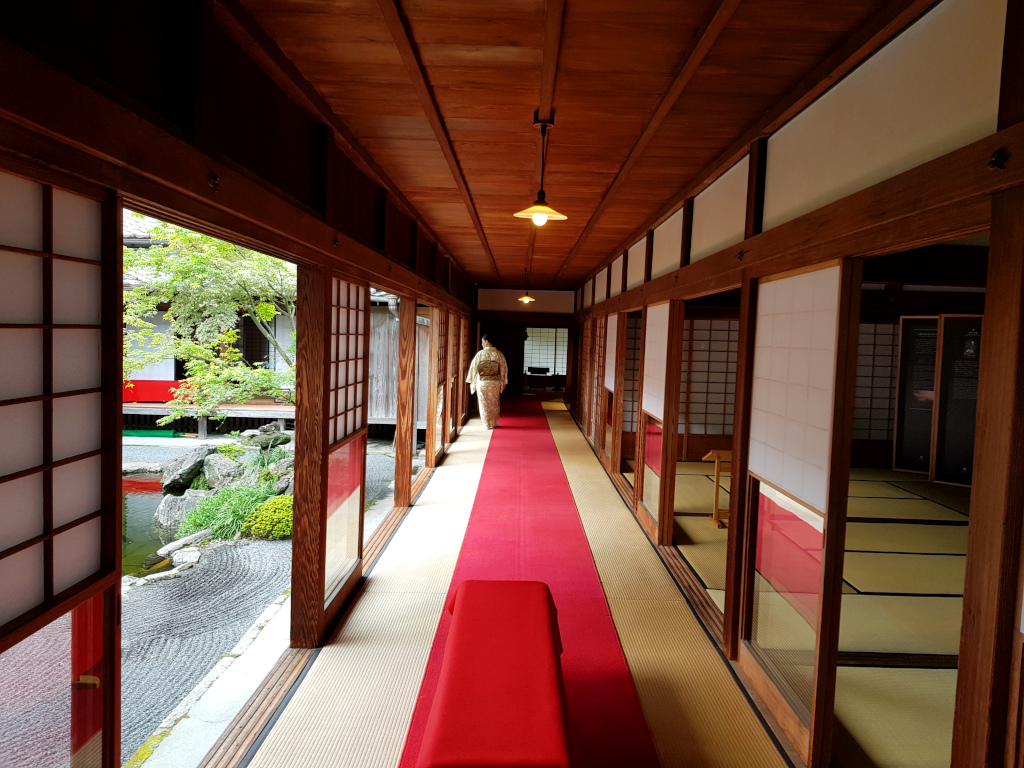
This morning starts with a visit to the traditional Japanese garden Sengan-en. Ask your hotel for the nearest bus stop to the garden: they know best. On the bus, you can buy a ticket for the day (which you will also need to go to Kagoshima Ferry Port after your visit to the garden).
The garden has many small ponds, temples, bonsai trees and a bamboo forest. The traditional Japanese house and the garden inside and just outside of the building are the highlights of the visit: they’re beautiful and well-maintained, clean and aesthetic and provide a good view of Sakurajima volcano island.
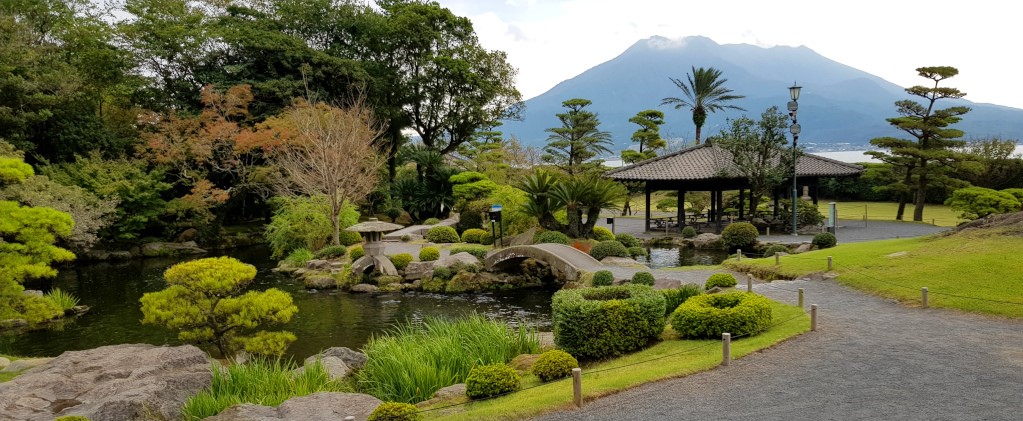
Do also head to the area behind the house and slightly up the hill for a more ‘wild’ and ‘ancient’ version of a Japanese garden. Pure nature with limited human intervention at its best.
I can also recommend the tea house in the garden. It is quite touristy but the ambiance and taste make up for it.
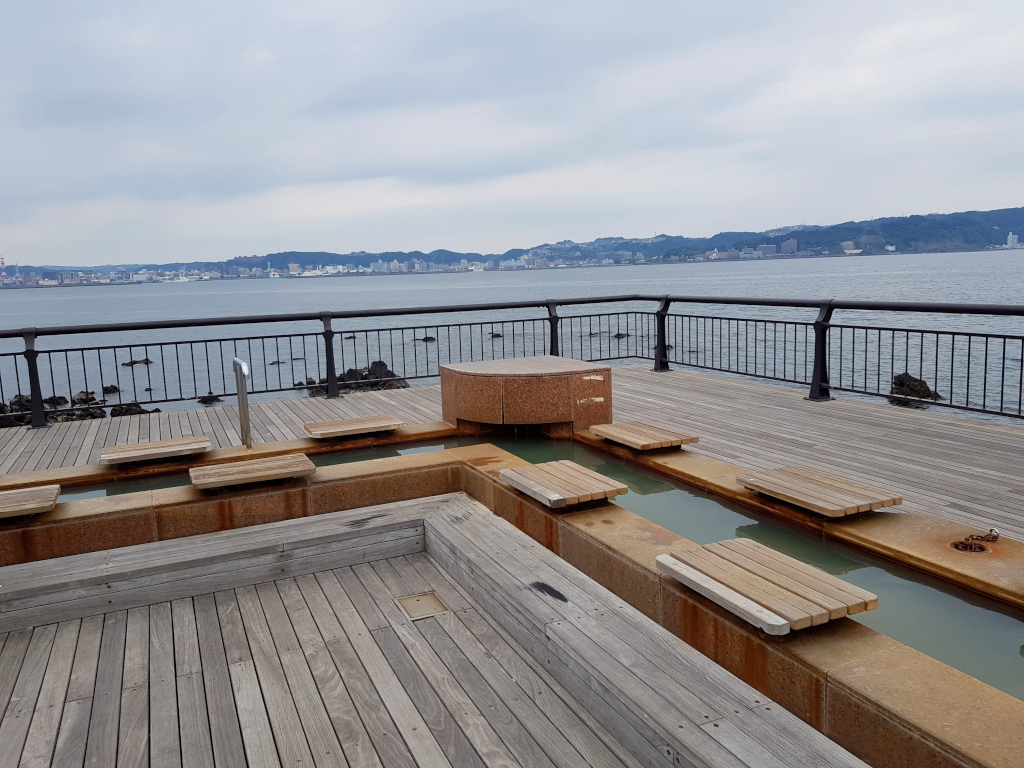
Take the bus from Sengan-en Garden to Kagoshima Ferry Port for a short 15 minutes’ ferry trip to Sakurajima Island. The ferry goes three to four times per hour between 6:00 and 20:00, so no need to watch the time.
At Sakurajima Island, I recommend buying a ticket for the Hop-on / Hop-off buses for a tour around the island. Beware though, this will be a very Japanese experience. The bus stops for like 5 to 10 minutes at every viewpoint or sculpture. That’s plenty of time to see it all but it still feels like ‘get out, take pictures, get in, move on’. In the end, you reach the observation point near the volcano (not that close) and can admire the view of Kagoshima across the sea.
Before heading back to Kagoshima, take a stroll along the coast towards Nagisa Foot Bath and Nagisa Lava Trail. The footbath is situated on the coast, so you can relax a bit with your feet in the warm (not hot) water with Sakurajima volcano on one side and Kagoshima on the other.
The Nagisa Lava Trail is a trail of about three kilometers along the coast. The blackened rocks date back to the eruption of Sakurajima volcano in 1914. It is a very nice stroll with beautiful scenery.
Where to stay in Kagoshima
Moving away from the bigger cities I always pick a more mid-range hotel as I often spend some time relaxing at the hotel. For Kagoshima, I wanted a hotel with a hot spring bath. And because I was traveling with someone with tattoos (often not allowed in public baths) I selected a hotel with private baths. In the end, I didn’t end up using a private bath because the public one was quiet enough that my friend could just go in without anyone seeing her tattoos.
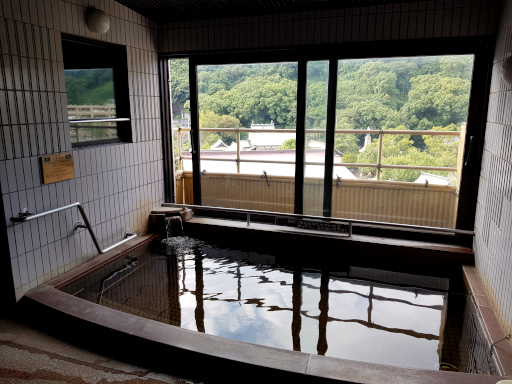
Hotel Fukiagesou is a very good mid-range hotel in Kagoshima. The furniture in the hotel room makes you feel like you’re back in Nagasaki’s Glover Garden, but the beds were surprisingly comfortable. The hotel staff was really nice and helped us find the right bus stop and bus times for Sengan-en Garden. I also enjoyed the breakfast at the hotel very much.
A small note for those that value English speaking skills: the hotel staff didn’t speak any English. This won’t stop them from explaining everything about the baths, the floor of your room and breakfast to you in Japanese. I was quite happy when I found out I could understand 75% of what they said. Apparently, I did pick up some Japanese listening skills on my previous trip to Japan (hotel and restaurant vocabulary only).
They have all the necessary information available in English on paper, so you won’t lack anything.
I enjoyed my stay at Hotel Fukiageso and can recommend it to anyone looking for a place with hot spring baths and a good breakfast.
Where to eat in Kagoshima
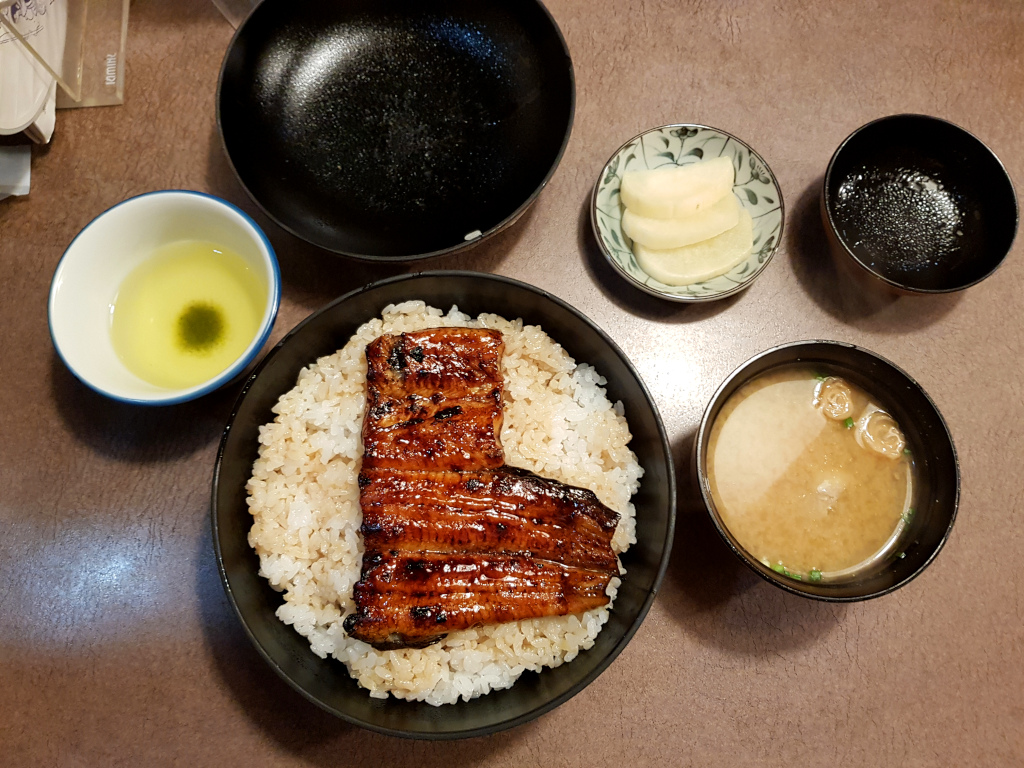
I found a good grilled eel (Unagi Don) restaurant (うなぎの末よし) in Tenmonkan Shopping Center. I’ve been a big fan of this dish since my last visit to Japan and I wish I could find a good restaurant selling Unagi Don in my country.
Yakushima Island
Yakushima Island is a small subtropical island off the coast of Kagoshima. On the island you can find many ancient cedar trees; some of them around 7000 years old though you’ll probably agree with me that a thousand years old is already a pretty respectable age for a cedar tree.
Day 7: ferry to Yakushima Island, Shiratani Unsuikyo
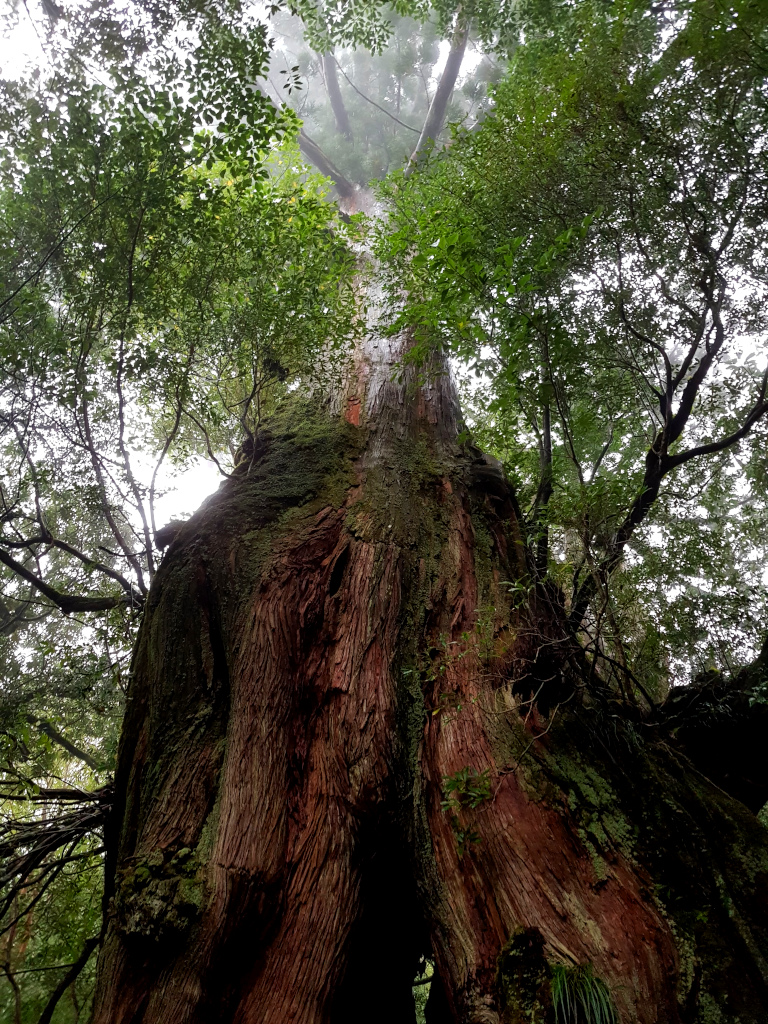
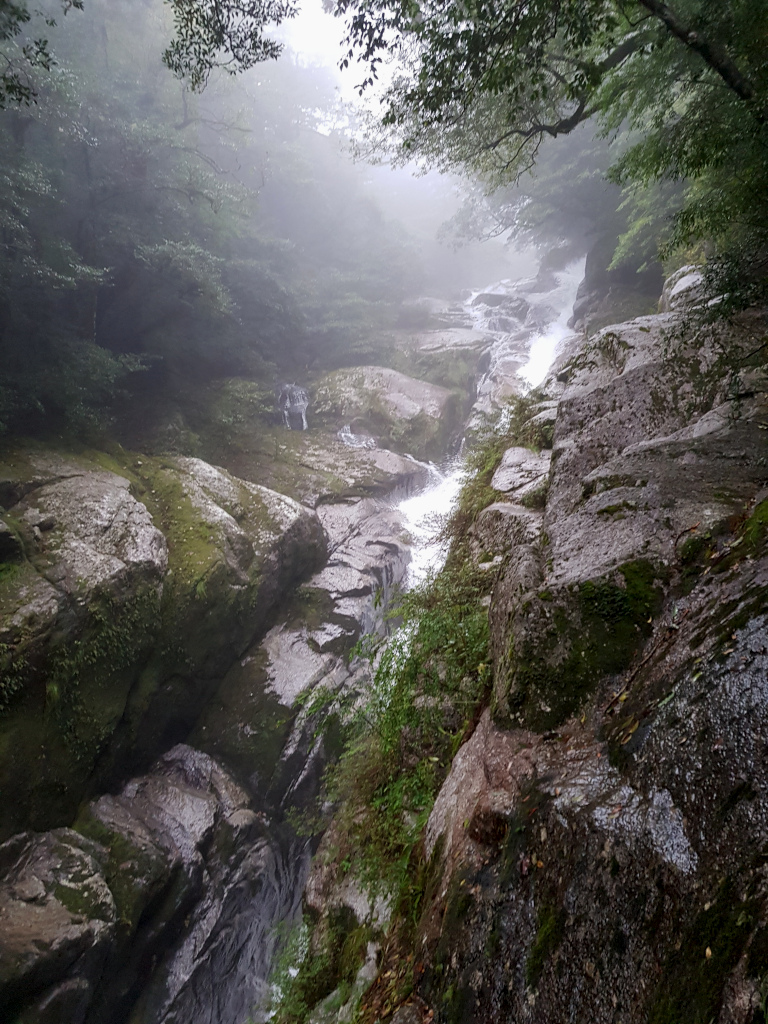
Take the morning ferry from Kagoshima Ferry Terminal to Miyanoura or Anbo Port on Yakushima Island. Pick up your rental car near the port and check into your hotel first.
The afternoon is for hiking in Shiratani Unsuikyo: a natural recreation forest that receives a lot of rain every year. It is best known for its very old cedar trees. This area was used as inspiration for the movie Princess Mononoke.
You can do one of the shorter trails (Yayoi Sugi trail) or start a 4-hour trail to Taikoiwa Rock.
Day 8: Tashiro Coast, Senpirono Falls, Seibu Rindo Forest Path, Inakahama Beach, Isso Harbor
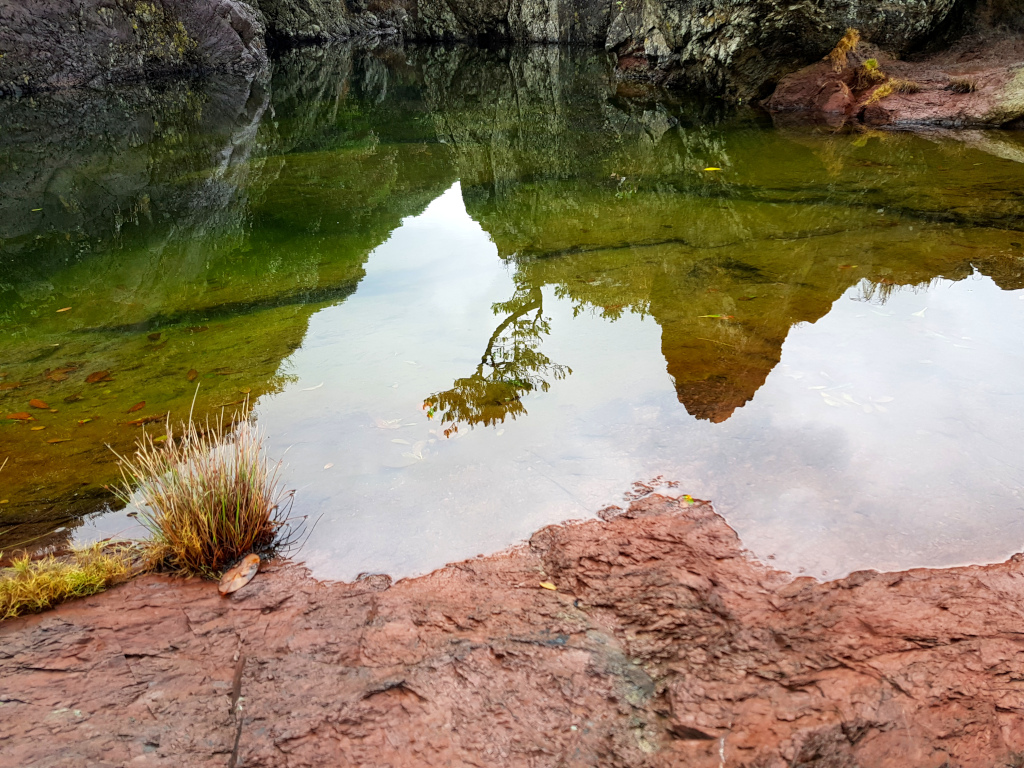
Let’s go on a Yakushima Island road trip today… unless you fancy a 10-hour hiking trip to Jomonsugi (the most iconic trail on Yakushima Island) that is.
With Miyanoura port as a starting point, drive clockwise until you reach the first stop of today: a Japanese tea shop (有屋久島八万寿茶園). They sell many types of tea grown on the island. You can try some of them before buying them.
Along the way, you will see many shops selling souvenirs made from Yakushima cedarwood. Feel free to stop at those that grab your attention.
The next big stop, and at the same time my favorite spot on Yakushima Island, is Tashiro Coast. This rocky coast formed by lava was one of the most colorful places I saw on my trip. Not in a bright neon billboards kind of way, but natural, subtle. Even though Tashiro Coast doesn’t seem like much at first, it will grow on you if you give it your full attention and observe.
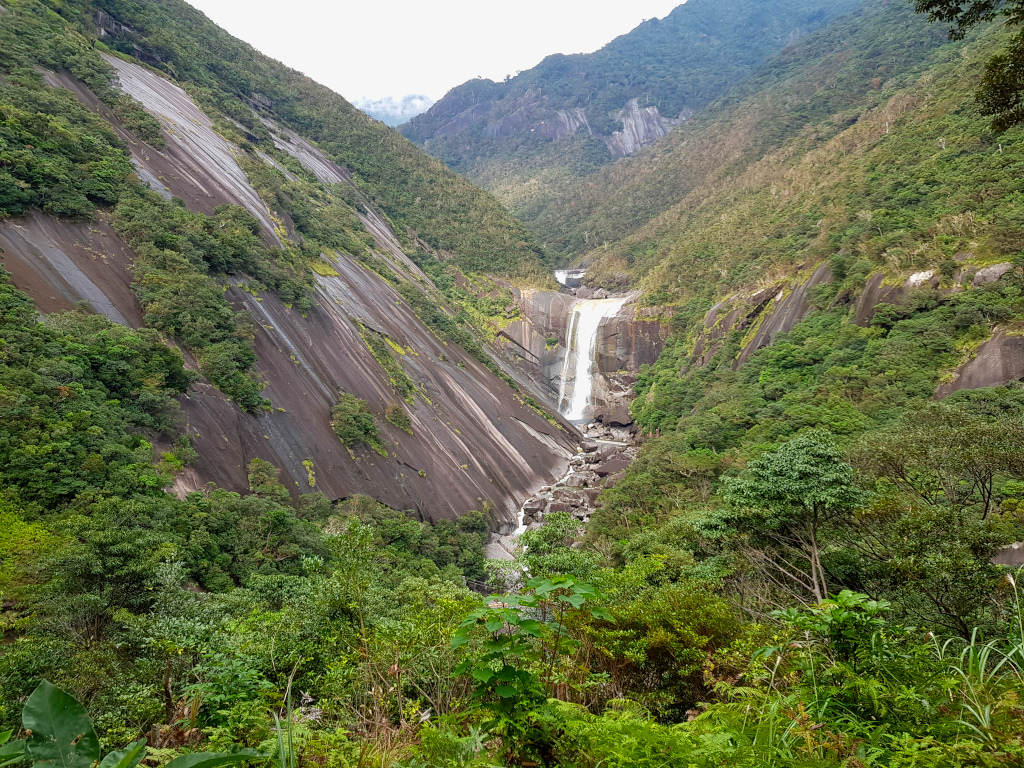
From there, pass Anbo to visit Senpirono Falls: a waterfall flowing over massive granite cliffs surrounded by forest. I almost wrote “big waterfall” there, but the waterfall is not that big at all. It just feels huge because of the valley surrounding it.
On the west coast of Yakushima Island, you will find Seibu Rindo Forest Path, which is a UNESCO protected forest. Along the often one-lane path, you can spot monkeys and deer. And if not: admire the diverse vegetation. There is plenty to see.
Heading further north you will come across some interesting beaches. One of them is Inakahama Beach, which sea turtles use as a nesting place from May to July.
Another popular white beach is at Isso. If you look at Isso from the other side though, overlooking the harbor from the Shinto Altar nearby, it feels more like you’re in the Lofoten in Norway.
You can read more about these stops in my Yakushima Special.
Day 9: Mount Tachu hike, Yakusugi Land
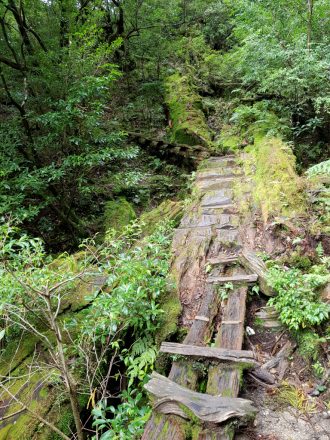
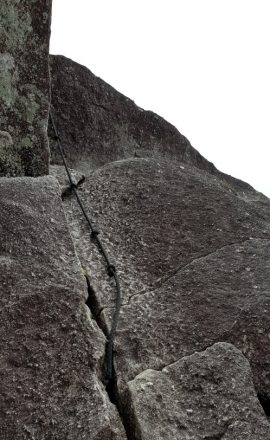
Today you will explore Yakusugi Land. Depending on what you feel like you can do the short two-hour forest trail and spend the rest of the day relaxing at a nice beach or cafe. Or hike mount Tachu.
The hike to Mount Tachu at 1497m has been designated as a UNESCO World Heritage Hike. It takes about 6 hours to do a return trip (with minimal resting).
You start in the forest until you reach the side track to Tenmon no Mori. After this, the relaxing forest walk is over and you start climbing.
From the top of Mount Tachu, you can see all the way to the coastal cities while celebrating your success on top of the big rock.
Where to stay on Yakushima Island
I chose to stay at Tashiro Annex in Miyanoura because you can get there quickly from the ferry. From there it is only a 20 minutes drive to the trails in Yakusugi land so you can do a trail on the day you arrive. The hotel offers Japanese and Western rooms and has hot spring baths for men and women. Laundry facilities are also present (very useful if you go hiking). You can eat dinner at the hotel if you make a reservation the day before and enjoy a multi-course dinner or walk into town to eat at one of the many restaurants. Breakfast is good but not too heavy.
Miyazaki
Day 10: Obi Castle Ruins and town
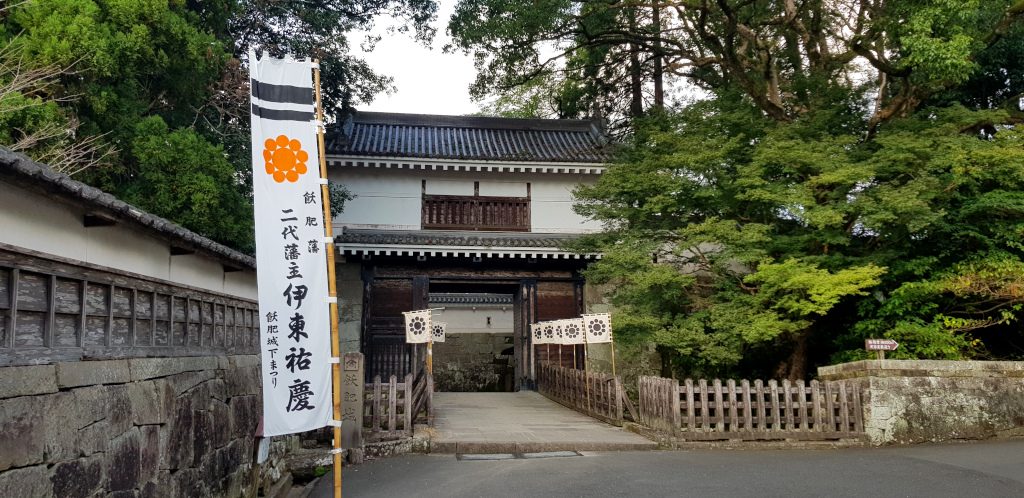
Drop off your rental car at Miyanoura Port and take the ferry back to the mainland in the morning. In Kagoshima, you will pick up your new rental car near the port.
Drive about two hours east towards Miyazaki to reach Obi. Obi is famous for its Castle Ruins. Even though it is called castle ruins, it doesn’t feel like it because many buildings were restored.
Around Obi Castle, you can see traditional Japanese gardens and houses in the so-called Obi Samurai Residence Street. You can enter some of the houses to learn more about the history of Samurai. I marked two of the Samurai residences you can visit on the Japan Travel Itinerary map. You can easily spot the others while wandering around the streets.
Day 11: Cape Toi, Udo Jingu Shrine, Sun-Messe Nichinan
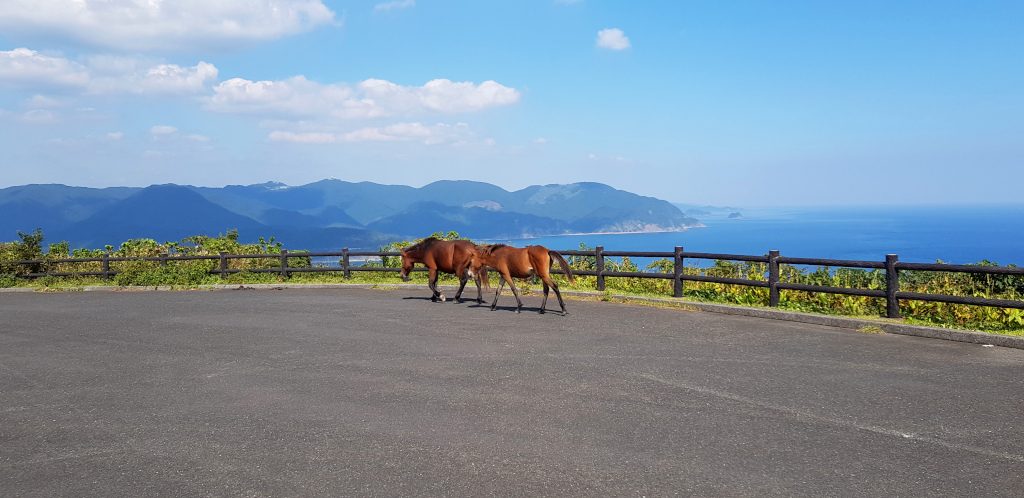
The first stop this morning is Cape Toi at the southeastern tip of Kyushu. Cape Toi is like a resort for wild horses. The horses have plenty of room to wander around and don’t mind humans taking pictures of them from a distance. Or from very closeby, but do keep in mind they are wild horses even though they’re used to having humans around.
You can visit the white lighthouse at the end of the cape for a breathtaking view of the cape and bay. You’ll wish you were one of the horses living there.
There is also another viewpoint providing a good view of Cape Toi but when I went there the horses were blocking the path so we decided to turn back and leave them be.
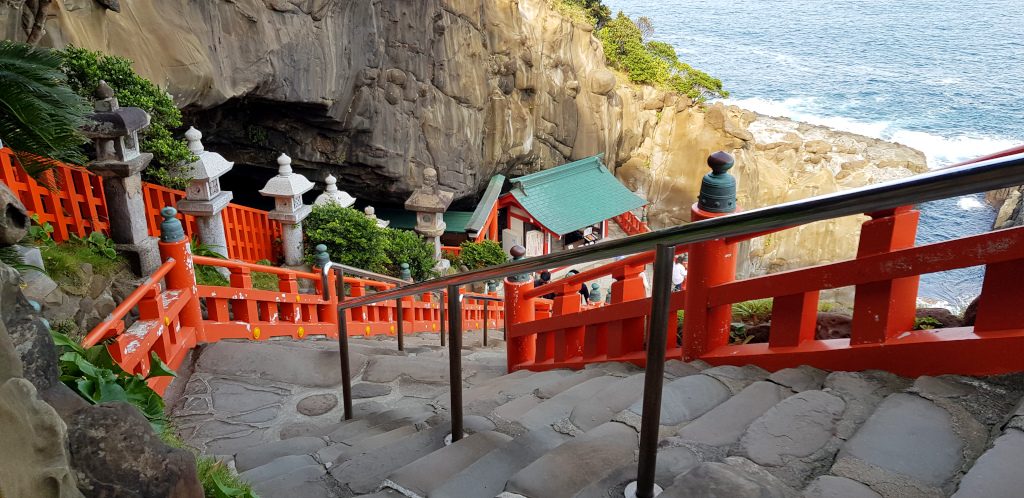
Take the same road back and stop at Udo Jingu Shrine. This stop is especially important if you want to increase your fertility and chances of a good marriage.
Follow the path through the red gate and down the coast to the colorful temple inside the cave. After visiting the cave, spend some time looking at the cliffs and rock formations. You can try your luck throwing lucky stones (Undama) at the rocks resembling a sea turtle in the hope your wish will be granted.
The last stop for today is Sun-Messe Nichinan to see the statues resembling the Maoi of Easter Island.
If you have some time left and want to go shopping, check out Aeon Mall in Miyazaki. It is open until 22:00 and houses my favorite modern green tea house Nana’s Green Tea.
Where NOT to stay in Miyazaki
I stayed at Kominka Sharehouse Hooju. The building is beautiful: a traditional Japanese farmhouse. The area is authentic, very near to attractions and the price is really low.
Until so far the positive review. The house is still very much in its old state and lacks maintenance. A unique look into history you would say. Yes, but not a pleasant place to stay at. I don’t mind the big spiders in the living room and kitchen or even the cold seeping in through all the spaces in the walls or roof. My problem was with the dust and everything else that irritated my airways from the moment I stepped inside. I tried to spend as much time away from the Sharehouse as I could, but it took days before I felt healthy again.
Where to eat in Miyazaki
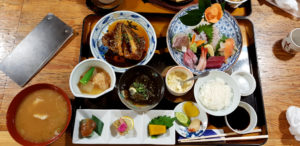
For the Aoshima area, I recommend 漁師料理 ひで丸. The entrance is a bit hidden behind a carport but you can just open the one door that looks like it might open. I had a very good seafood meal with many side dishes.
Mizukami
Day 12: Aoshima Island, Ebino Plateau
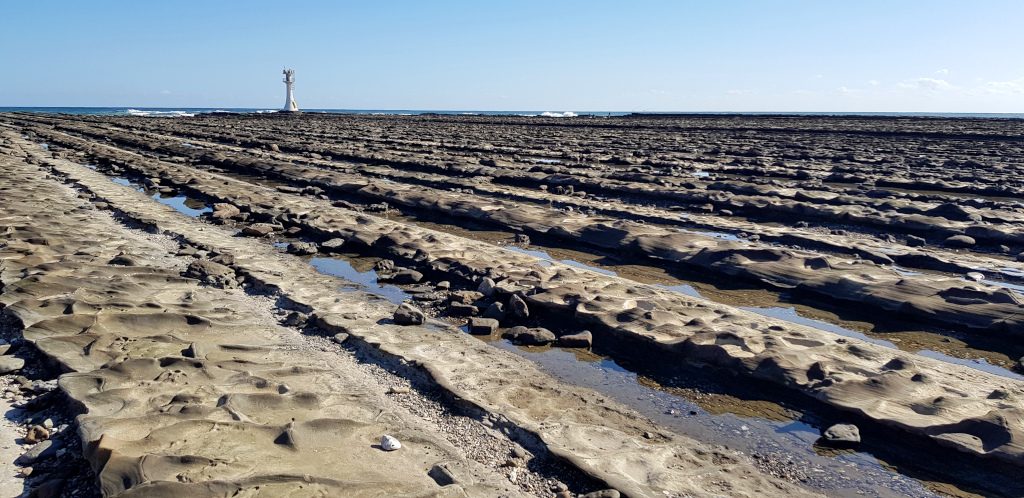
This morning starts at Aoshima Island: an island connected to the mainland by a bridge. What makes the island special is that the vegetation resembles a jungle.
Via the path to the right of the main temple, you can reach a smaller temple in the middle of this jungle. It is a very unique thing to experience in a non-tropical area.
Heading back to the coast of Aoshima Island, you can see the Devil’s washboard (Oni no Sentakuita) at low tide. The Devil’s washboard is a natural formation even though it looks like it was created by humans.
If you can, try to be at Aoshima Island around 8:00 in the morning to avoid the crowds. After that, it gets really busy. You can park your car for free at Miyakoh Botanical Gardens. It is only a short walk from there along the coast lined with palm trees.
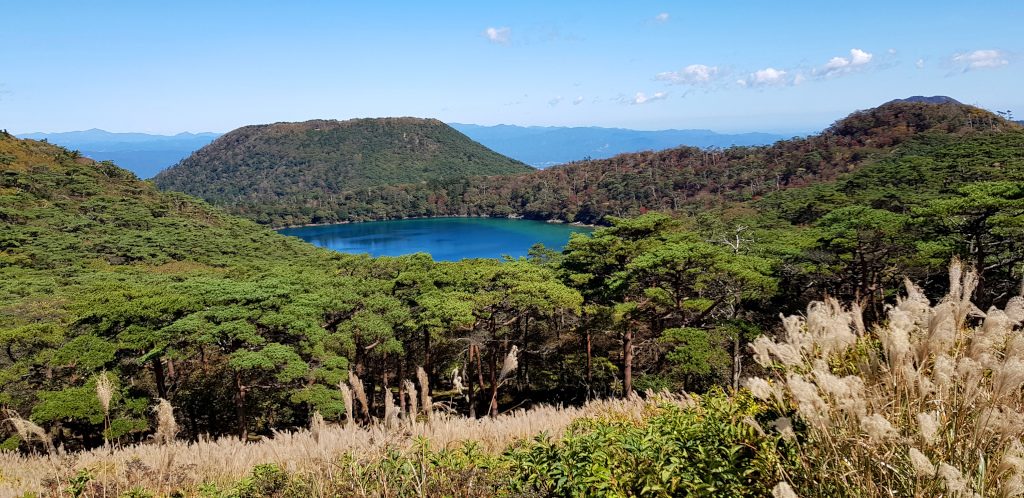
Drive an hour and a half west to visit the lakes at the Ebino Kogen in an area filled with volcanoes and craters. You can do an easy 4 kilometers walk around the blue lakes (Lake Byukushi and Lake Rokkannonmi) and spot wild deer.
When I visited in October 2018 I could only do part of the trail because of volcanic activity in the Kirishima area. Most of the no-entry zones were lifted in spring 2019 but some access roads and paths around small craters are still closed. Please check the current status before your visit.
From there head to your hotel in the Mizukami or Aso area for a relaxing evening in a hot spring bath.
Where to stay in Mizukami
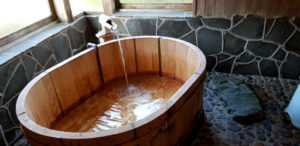
The building I rented a room in was beautifully constructed and I basically had the whole building to myself. It was one of the most aesthetically pleasing stays of my trip. The hot spring bath made my skin feel extremely soft. It was also the bath that smelled like sulfur the most… so more healthy minerals?
Aso
Day 13: Takachiho Gorge, Amano Iwato Shrine, Amano Yasukawara
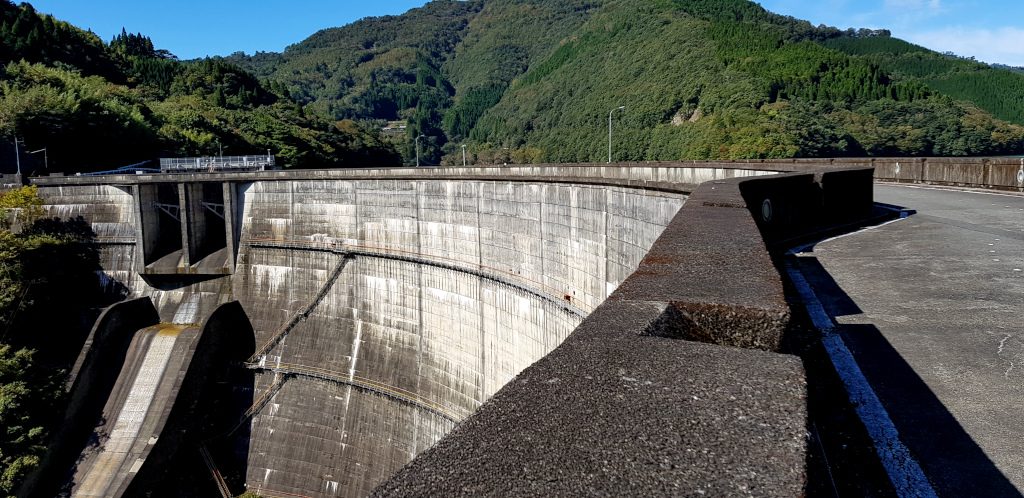
Take the mountain road for two and a half hours to Takachiho Gorge. Make a quick photo stop in Shiiba to see the Kamishiiba Dam. You can drive all the way to the start of the dam (while feeling you’re not allowed to drive there) for a short walk on top of the dam with a view of Shiiba.
Takachiho Gorge is best known for its very blue water surrounded by high cliffs. You can take a boat and watch it from below or walk along the stream for a different perspective.
When it’s busy you can’t park near the entrance of Takachiho Gorge and you have to resort to the parking lots uphill. It is quite steep…
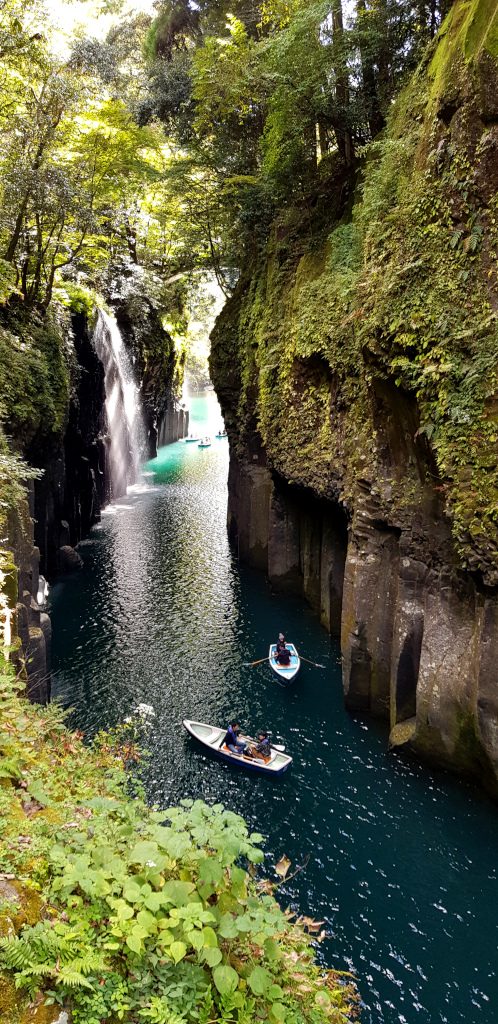
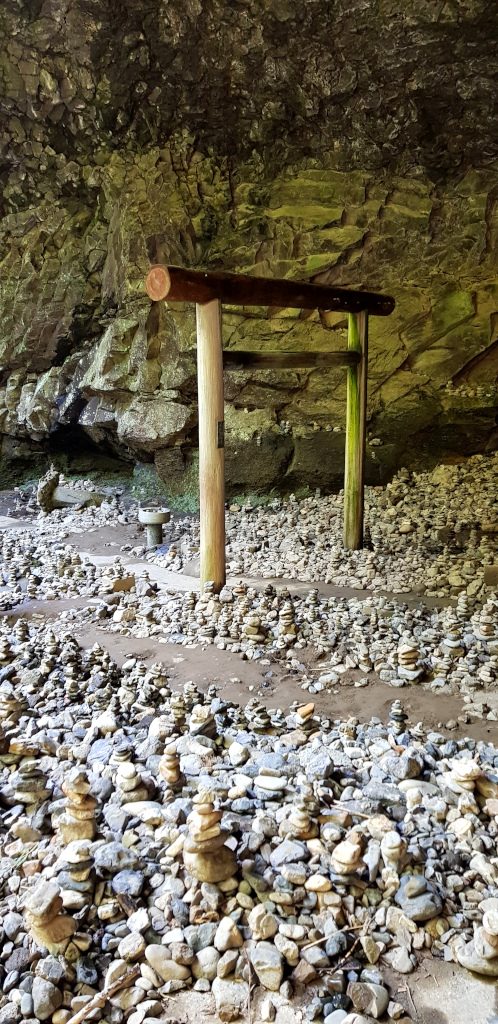
Near Takachiho Gorge you can visit Amano Iwato Shrine and Amano Yasukawara. Both shrines are at a beautiful location along a stream, surrounded by trees and make you feel like you’re far away from society.
From Amano Iwato Shrine you follow the path lined with shops (take-out ice cream) and a stream resembling a mini Takachiho Gorge to a remote temple (Amano Yasukawara) built in a cave. In the cave you can see the wooden shrine and many piles of stones, making you feel like a recluse at the perfect photo stop.
After your visit to the shrines, continue to your hotel in Aso. See if you can time this part of the trip a bit before sunset so you can see the sun go down behind Aso Volcano and the hills in the area.
Where to stay in Aso
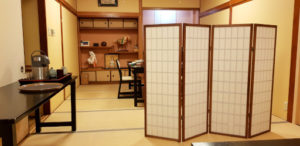
And it was worth it. A very relaxing stay where everything is taken care of. Lots of space to move around and a hot spring resort experience (that is not a thousand euros per night) at a traditional Japanese house.
On my previous trip to Japan, I stayed at a hotel across the street. Both hotels provide a similar experience. So, see if you can book one nice hotel in the Aso area to treat yourself for a trip going well.
Beppu
Day 14: Mount Aso, Tadewara Wetlands
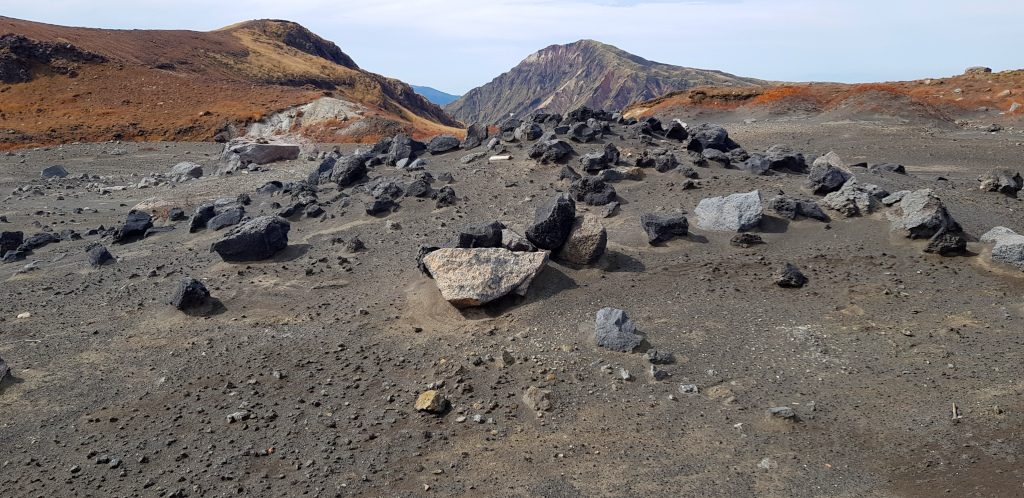
It is time to visit Mount Aso, the largest active volcano in Japan and one of the biggest calderas in the world. One of the peaks, Nakadake, continuously emits smoke and you will need to check the current status to see if you can visit.
You can park your car at the start of Mount Aso Ropeway, but it is also possible to take the toll road (800 Yen) and park near the crater.
There are many walking paths at the top that you can take to see more of the area. I especially liked the view of the mountains from a path of dark sand and rocks with tiny bushes turning orange for autumn.
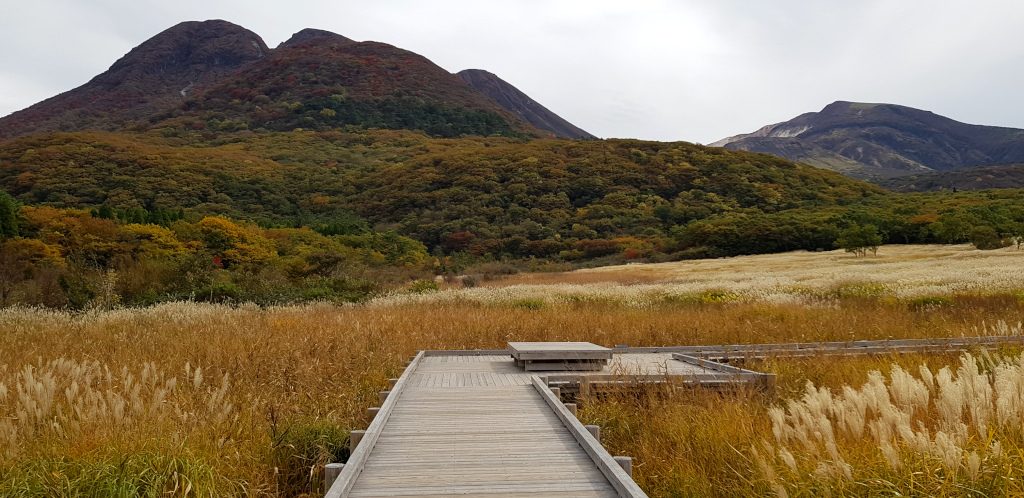
Take the mountain pass through the Kuju Mountains to get from Aso to Beppu. Halfway you can make a stop at Chojabaru Visitor Center for a short walk through the Tadewara wetlands. From the wooden boardwalk, you have a good view of the mountain range and you can try to spot some birds in the reeds.
In the evening you can go shopping in YouMe Mall Town Beppu.
Day 15: Beppu
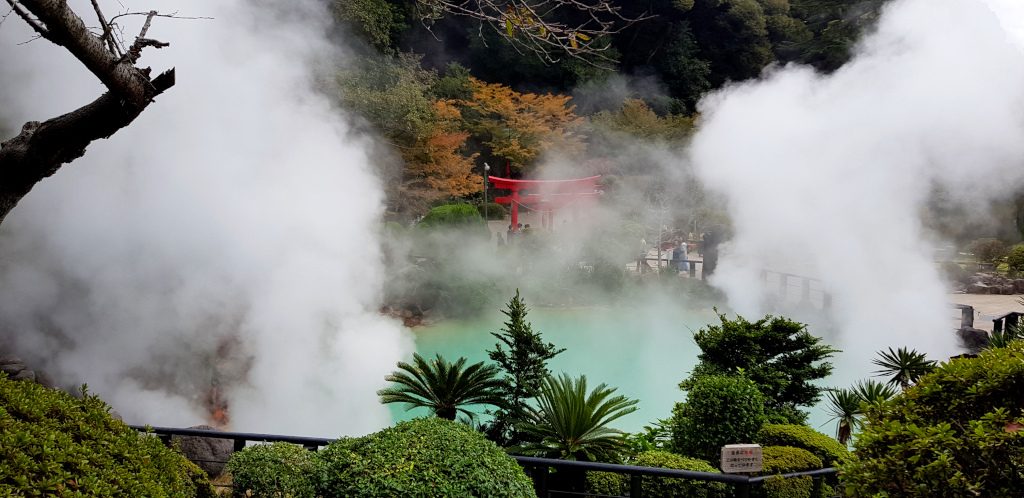
The last day of your trip, feels like hell, right? A perfect day to visit the boiling hells of Beppu.
Take the bus from your hotel to Kannawa Onsen. This is the starting point for a visit to most of the Beppu hells. You can buy a passe-partout for all hells at any of the Hells for 2100 Yen.
In no particular order you will visit:
- White Lake Hell (Shiraike Jigoku): a milky white pond with a small garden surrounding it.
- Mountain Monster Hell (Onimaya Jigoku): a small pool with crocodiles in tiny cages. Skippable!
- Cooking Pot Hell (Kamado Jigoku): small green pond where you can enjoy a foot bath and eat steamed egg and tofu.
- Mountain Hell (Yama Jigoku): small pool with animals in small cages. Not worth a visit in my opinion.
- Ocean Hell (Umi Jigoku): a beautiful pond with tropical blue color.
- Monk Hell (Oniishibozu Jigoku): mud pools with bubbles. A very interesting Hell to visit.
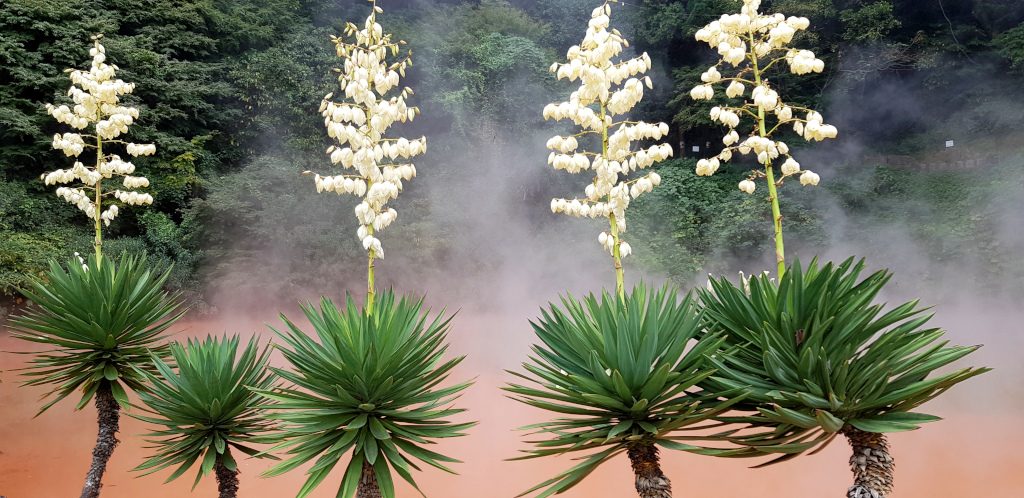
After visiting these five hells of Beppu, you can take the bus or walk in thirty minutes to the location of the remaining two hells. I recommend walking, as the path will lead you through a quiet Japanese neighborhood with many things to see.
The remaining two hells:
- Blood Pond Hell (Chinike Jikogu): a hot, red pool with beautiful plants at the edge. This one is great for taking pictures.
- Geyser Hell (Tatsumaki Jigoku): a boiling hot geyser that sprouts twice per hour.
All Beppu Hells have good souvenir shops, but the best are at these last two hells. This is where I bought my very own red demon amulet that is now hanging in my Christmas tree.
You can buy a ticket for all Beppu Hells for 2100 Yen (Oct 2018 price) or pay 550 Yen entrance fee per hell. I think most of the hells are worth visiting, so buying a combined ticket is cheaper in the end.
After visiting the Beppu Hells you can walk down the hill to the train station and take a short train right back to the center of Beppu.
Where to stay in Beppu
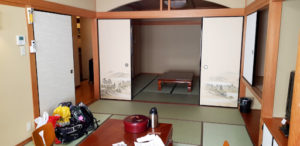
I stayed in a Japanese room at Umikaoru Yado Hotel New Matsumi. The Japanese room is very big: you get two rooms basically. The hotel has public hot spring baths and free breakfast is included.
The hotel is at a very good location near Beppu train station and bus lines to Kannawa Onsen. You will find yourself surrounded by awesome small bars and pubs for dinner. Another thing worth mentioning: one of the staff members spoke very good English. I was really impressed. I don’t know if she will be there during your visit but for us, it meant a very smooth check-in experience.
Ending your Kyushu and Yakushima Island trip
This was the last day of the trip. Time to go home.
You have several options here.
- Spend a few days in Tokyo. I dropped off my rental car at Oita airport and took a plane to Tokyo for a few more days in the capital of Japan.
- Fly home via Tokyo. Do the same as above, but transfer to another plane in Tokyo instead.
- Fly home via Fukuoka. Drive to Fukuoka and drop your car off at the airport and take a plane home. Alternatively, you can drop off your car in Beppu or Oita and take the train to Fukuoka.
Practical information
How to get to Kyushu and start your trip
Kyushu is easily reachable by train, air, and boat.
By air
There are many airports on Kyushu Island. To name a few: Fukuoka, Nagasaki, Kagoshima, Oita. I flew from Amsterdam to Fukuoka (via Seoul), but you can easily fly to another airport in Japan and take the train to Fukuoka. If you are flying to Nagasaki, you can skip the day in Fukuoka and start this itinerary on day two.
By train
You can take the high-speed train from Tokyo or Osaka to Fukuoka station to start this round trip.
By boat
If you’re coming from South Korea (Busan area) you can catch a boat to Fukuoka.
Transport
In this itinerary, you will use both public transport and rental cars.
Fukuoka to Nagasaki to Kagoshima
You will travel the big distances by train using an All Kyushu Japan Rail Pass. Take the 5 days option costing 18,330 Yen (Dec 2019 price). This will cover your trip from Fukuoka to Nagasaki and your trip from Nagasaki to Kagoshima and will also allow an optional trip to Huis ten Bosch.
Within cities
Within Nagasaki, Kagoshima, and Beppu you will travel by bus and tram. I had a PASMO public transport card from a previous trip but only used it to get from the airport to the hotel in Fukuoka and in Beppu.
You have to pay the tram in Nagasaki in cash. Make sure you have small coins with you at all times, as you have to pay an exact fee; no change on the tram.
In Kagoshima, I bought a day ticket for the bus.
Ferries to Sakurajima and Yakushima Island
The ferry from Kagoshima Port to Sakurajima Island is very cheap. You can buy a ticket at the ferry port right before your trip. No need to reserve a seat in advance.
It is necessary to buy a retour ticket to and from Yakushima Island in advance. You can try buying one at the ferry port on the day you arrive in Kagoshima, but it is risky. You can read more about how to get to Yakushima Island in my Yakushima Island Special.
Rental cars
You will use two different rental cars on this trip. One on Yakushima Island (pick-up and drop off at the ferry port) and one from Kagoshima on day 10 until your last day in Beppu.
In theory, you can do this Japan trip by public transport. You’ll lack a lot of freedom though and you will need to skip certain activities.
When I visited Aso and Yufuin on my first trip to Japan in 2015, I immediately decided to come back later to explore the same area by car. My visit to this area was so much more worthwhile in 2018 because I could reach more remote spots along the way and stop whenever I wanted to take a picture.
Budget
This budget is based on a two-person party. It will be more expensive if you travel solo and have to pay for your accommodation and rental cars alone.
Transport
- Flight from your hometown to Fukuoka: costs depend on where you live
- Japan Rail Pass: 150 EUR (167 USD) per person
- Hiring a car on Yakushima Island: 128 EUR (143 USD) in total
- Hiring a car on the mainland: 418 EUR (466 EUR) in total
- Gasoline: around 1000 kilometers for around 80 EUR (90 USD) in total
- Ferry to and from Sakurajima: less than 3 EUR (3 USD) per person
- Ferry to and from Yakushima Island: 127 EUR (142 USD) per person
- Other public transport: less than 5 EUR (5 USD) per person
Food
- Around 30 EUR daily per person for 15 days: 450 EUR (502 USD) per person
Accommodation
- Around 40 EUR daily per person for 15 days based on low to mid-range hotels: 600 EUR (669 USD) per person
Wifi
- 44 EUR (49 USD) in total for 15 days. You can order a Pocket Wifi via Klook.com or GetYourGuide.
Entrance fees
- Less than 50 EUR (56 USD) per person
Souvenirs
- As much or as little as you want
Keep in mind that this is just an estimation based on the trip I did in October 2018. It cost me around 1720 EUR (1918 USD) per person for a party of two, including all the above, but excluding intercontinental flights and souvenirs. If you do this trip on a budget (cheaper hotels and food) the total cost will be much lower.
